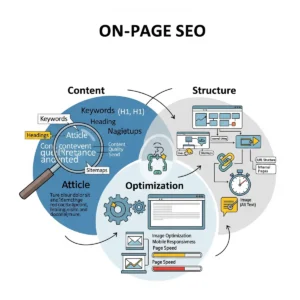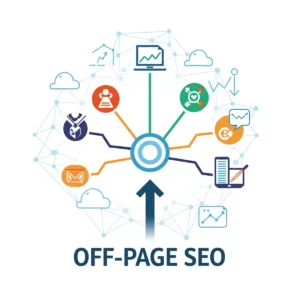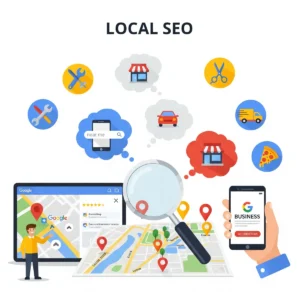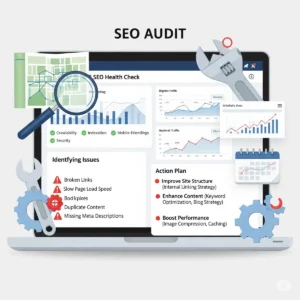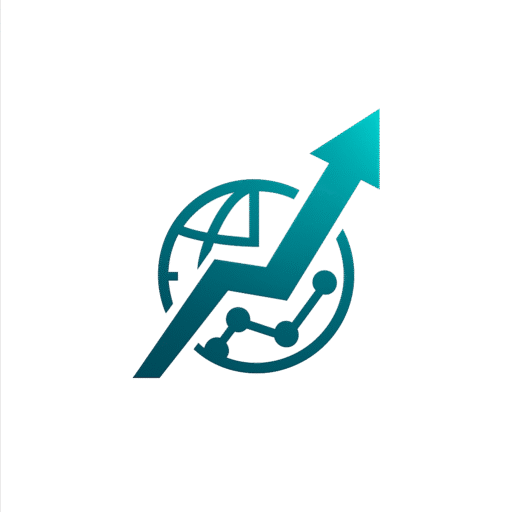On-Page SEO Techniques: How to Optimize Your Content for Better Rankings
Over the past few years working with SaaS clients at Tech Buzz, I’ve learned that mastering on-page SEO is not just about optimizing keywords—it’s about creating an ecosystem where your website content aligns with user intent, technical precision, and conversion rates. The first step always begins with deep keyword research—and tools like Ahrefs and Semrush help uncover golden opportunities, not just high-volume terms but intent-matching ones that fuel organic traffic.
But research is just the start. The true art lies in content creation that blends high-quality content with smart internal linking, strategic headings, and purposeful structure. Even with the best copy, poor page load times can hurt your search engine rankings—a mistake I learned the hard way until I began optimizing every image and reducing code bloat. Using Yoast helped streamline metadata, while frequent updating content keeps things fresh and boosts visibility. One of my favorite case studies involved a client whose rankings shot up 73% simply by restructuring outdated posts and aligning them with refreshed keyword intent. It’s this kind of hands-on refinement that turns static pages into lead machines.
What is SEO?
Before diving into advanced tactics, it’s crucial to understand the foundation of SEO—search engine optimization is essentially the practice of improving your website and landing pages to increase their chances of appearing when users type relevant search terms into search engines like Google or Bing. In my early days of SEO consulting, I realized many site owners were solely focused on flashy design, overlooking the core functionality and content needed to truly rank. What they missed was that effective SEO is not a single fix but a strategy—a combination of finely-tuned components like crawlable structure, informative content, and technical soundness. Everything from how fast a page loads to how keywords are placed plays into how well your site communicates with both users and algorithms.
10 Advanced On-Page SEO Techniques to Boost Your Rankings
In the ever-evolving world of on-page SEO, I’ve found that relying on basic optimizations alone won’t help your website stand out in competitive markets. To truly boost your rankings, your strategy must go beyond the surface—focusing on how users and search engines navigate your site. I’ve tested dozens of advanced strategies over the years with tech businesses, and the ones that consistently deliver results are well-planned and deeply structured, enhancing both the browsing experience and measurable metrics. Techniques like optimizing how keywords are placed, improving how fast your page loads, and aligning content to user experience can transform your search results performance.
One game-changing approach I often use is mapping content around valuable information that speaks directly to audience needs, encouraging engagement and action. This keeps visitors more engaged, leading to better time-on-site stats and ultimately helping the site rank higher. When done right, these techniques not only increase visibility and organic traffic, but also convert that traffic into loyal customers. Every detail—whether it’s a faster load time or smart internal linking—adds up to the kind of success that gives businesses an edge and connects them with potential customers searching for exactly what they offer. That’s the real benefit of investing in intelligent on-page SEO.
1. Spend time on competitor Research
One of the smartest moves I made early in my SEO journey was taking competitor research seriously—not just scanning their site structure, but diving deep into what makes successful sites in my niche stand out. Using tools like Ahrefs, I regularly analyze the keyword report, identifying what competitor keywords are driving traffic and which pages hold the most authority. When I worked with a health blog targeting paleo diet recipes for vegetarians, I found several low hanging fruits by spotting long-tail versions that close competitors weren’t targeting—a huge win that helped us rank faster.
From the dashboard, I’d export the most valuable backlinks of superior sites into a spreadsheet, then filter out broken links and recreate the content with better value. Then came the manual outreach: I’d gather contact details, craft a solid pitch, and offer to replace the dead link with our updated version. I even discovered high-authority guest post opportunities by checking where competitors had contributed, matching their guest site list, and securing posts myself. Always use the search bar and report functions wisely—it’s not just about spying, it’s about understanding your space, replicating what works, and improving it. A simple overview of a domain name can uncover surprising opportunities that are easily accessible to those who know how to look.
2. Monitor crawling
One of the overlooked but critical areas of on-page SEO that I regularly prioritize is to monitor how Google and other search spiders crawl your website. Early in my career, I once found that dozens of web pages were being ignored, simply because a misplaced meta tag with noindex was embedded by a plugin in the administrator login area. It’s these small lines of code that can silently stop important pages from being indexed, effectively removing them from search results pages—and in turn, preventing them from helping you rank.
A quick glance at your robots.txt file can also uncover site-wide blocking rules like **User-agent: * Disallow: /**, which can mistakenly restrict crawling and indexing altogether. Using tools like Check My Links (a handy Chrome extension), I often analyze internal links, external links, and detect broken links right on the current page—which helps clean up harmful signals and identify abandoned paths. Even a single broken link might affect how search spiders interpret your site’s authority. Through careful crawling review and spot checks, using the find feature in the browser, I ensure nothing crucial is accidentally blocking discovery or progress. It’s small things like these that separate optimized pages from invisible ones.
3. Analyze your links
When I audit any website, whether my own or a client’s, I treat link analysis as a central part of my on-page and off-page strategy. It’s not just about how many links you have, but where they’re pointing, how pages are linked internally, and what kind of link neighbourhoods you’re sitting in. For example, I’ve seen well-designed product pages or affiliate pages struggle to rank simply because their internal links were poorly structured or non-existent. Running a solid internal link analysis often uncovers opportunities to send links from authoritative pages—a great way to pass link juice where it matters most.
Equally, external link analysis is crucial. With Ahrefs, I pull a complete backlink analysis report and isolate spam sites that are harming the quality of the backlinks. The metrics in these tools help me filter out the bad and build a healthy link prospecting list—essential for clean SEO growth. As a bonus, identifying relevant links from sites that competitors are using can lead to fresh outreach targets. When webmasters see their pages linking to your valuable resource instead of outdated content, that’s when your Google rankings begin to respond. The key is always to review every link analysis report with intention—not just to clean up, but to build stronger paths for visibility and trust.
4. Analyze your keywords
In my experience, one of the biggest mistakes SEOs make—especially when managing a new site—is skipping deep keyword analysis before building content. I’ve seen cases where different pages on the same site unknowingly target the same keyword, which often leads to keyword cannibalization, confusing Google on which particular page to rank. That’s why every post I publish goes through a clear keyword analysis report, where I align the focus keyword with related keywords, eliminate unrelated keywords, and avoid overlap across the site.
Over time, tracking keyword position movement reveals whether your optimization techniques are actually working, especially when dealing with the sandbox effect that many new domains face. For established sites, the goal shifts more toward refining for conversions. I often review conversion rate data and remove poorly-converting keywords, replacing them with ones backed by intent and relevance. One of my favorite wins came from replacing a keyword on a product page that had traffic but no conversions, leading to a dramatic uplift after targeting a better-suited variation. Tools that show search positions, ranking history, and even links associated with keywords can help decide what to keep and what to change. It’s this ongoing analysis that keeps your SEO tight, clean, and profitable.
5. Implement current on-page SEO techniques
One of the most essential lessons I’ve learned managing content-heavy WordPress sites is how quickly outdated techniques—like keyword stuffing—can ruin your chances of climbing in page rank or worse, trigger a Google penalty. Today’s on-page SEO is all about precision and intent. I always start with a clear plan, mapping each keyword to a specific post and avoiding overlap. The title tag, meta tags, h1 tag, and even the page’s code are double-checked to confirm they’re clean, relevant, and within the right character limit.
When working on niche content like paleo diet recipes, I use long-tail variations and modifiers to make my title more descriptive without sounding robotic. Crafting a keyword-rich but natural permalink—something like yourdomain.com/easy-paleo-diet-recipes—is one of those small tweaks that feels invisible but boosts your SEO-friendly structure. Whether you’re on any platform or customizing permalinks directly, ensuring every page aligns with current best practices makes a noticeable difference in visibility and longevity.
6. Create a mobile-friendly website
A few years back, I noticed a sharp drop in conversions on one client’s site, despite high mobile traffic. After running it through Google’s mobile-friendly checker, the report highlighted obvious issues—text too small, buttons placed too close for a thumb, and images that didn’t load quickly. In today’s world, where most people access the internet via a smartphone, creating a Mobile Friendly website isn’t optional—it’s a vital technique for making money and staying visible in search.
I always start by ensuring the design is responsive so it adjusts to both desktop screens and mobile phone dimensions seamlessly. When using WordPress, I rely on clean code and lightweight plugins to avoid bloating the site’s pages. It’s important that social icons, chatbots, and every message icon or action element are easy to tap—even with clumsy thumbs. Thoughtfully placed navigation buttons, readable text, and optimized images make a big difference in keeping visitors engaged. And don’t underestimate the power of clear social sharing icons—they can supercharge content promotion when your mobile layout invites interaction. These optimizing techniques ensure every page performs flawlessly across devices, reinforcing your credibility and helping you scale.
7. Monitor google search console
One of the most valuable habits I’ve developed as an SEO professional is to constantly monitor Google Search Console—not just to check performance, but to stay alert to critical issues that can derail a website. Whether it’s unexpected crawl errors, 404 errors, or a flagged manual penalty, this tool gives evidence directly from Google, helping you fix problems before they impact rankings. I’ve worked with developers and designers who overlooked this, assuming the site was fine, only to discover issues buried under the manual actions bar. Staying proactive here means fewer surprises during an algorithm update or sudden algorithmic penalty.
What sets advanced SEOs apart is how quickly they adapt to Google’s shifting guidelines, and the search console is where those changes often appear first. It notifies you about mobile usability issues too, ensuring your responsive website meets quality guidelines. I once avoided a full ban on a client’s blog after discovering spammy pages via the console before any human reviewer acted. And I always follow top SEO blogs after an update, cross-checking insights with my account data. If you’re a service provider, nothing builds client trust faster than real-time problem-solving and a pulse on SEO health—and this platform makes that much easier and more engaging.
8. Update your old content
One of the most overlooked but incredibly powerful tactics I rely on is going back to old content—those evergreen posts you once published that may now be buried deep in the SERPs. With Google valuing content freshness more than ever, I’ve boosted ranking for several clients by simply rewriting and re-optimizing articles written years ago. I once had a blog post from 2009 on link building tips that was packed with outdated practices. After revising it with new tips, modern keywords, and better formatting, it climbed back onto the first search engine results page within weeks.
It’s not just about SEO—it’s about credibility. A post on leadership principles that still refers to obsolete ideas doesn’t show you’re a good leader in your niche. I always remind clients: the work doesn’t end after you hit publish. Revisit your best-performing content, insert a refreshed keyword, and align it with what’s relevant today. Sometimes, one update can do more than a brand-new post.
9. Publish long-form content
Over the years, one of the strongest SEO levers I’ve pulled consistently is publishing long-form content—not just bloated text, but well-structured, value-driven posts that go beyond 1000 words and keep readers glued. I always start with a focus keyword, then build around related terms and long-tail variations that naturally fit the title, meta tags, and body. This type of content not only gives more room to explore subtopics but also boosts time on site, a metric that signals relevance and depth to Google.
Every page I build with this format is crafted to target intent, with minimal fluff and zero filler. What most people overlook is that long content doesn’t just serve SEO—it’s a subtle form of self-promotion. The longer readers stay, the more they trust your authority, and that opens up opportunities beyond just ranking. When done right, long content becomes an evergreen hub that pulls consistent traffic and builds topical strength over time.
10. Content evaluation
When it comes to modern content evaluation, the old saying “content is king” still holds true—but only if that content is original, relevant, and deeply aligned with user intent. I’ve seen websites suffer from non-SEO problems like plagiarized content, poor grammar, or massive blocks of text that instantly hurt user experience. That’s why I run every post through Copyscape or Copy Scape to spot any duplicate or broken pieces, and tools like Grammarly help fine-tune word usage to match the tone of a native English speaker. It’s not enough to copy and paste a few ideas—you need to create something that actually answers the searcher’s questions in a way no other page does.
To get that edge, I use SEO Competitor Analysis as a base, then 10x the value. That’s the real secret sauce—don’t just match what’s already ranking; go deeper, researching, simplifying complex parts, using images to explain, and focusing on conversations that lead to conversions. Whether you’re updating existing content or starting from square one, aim for in-depth clarity over fluff. For most queries, 300 words won’t cut it—often the magic number is 1,000+ to truly rank. Every time I evaluate my site’s top performing pages, I ask: is this the best answer available? If not, I adjust it—or reinvent the wheel entirely. That hard work pays off in organic traffic, visibility, and trust across platforms.
What to do instead: 10x it!
If there’s one secret sauce that’s consistently helped me outrank competitors, it’s this: don’t just create content—10x it. The difference between something that simply shows up in search results and something that ranks high on Google is how well it answers the searcher’s questions. That’s why I never settle for surface-level pages. I identify the queries, understand user intent, and then craft in-depth content that delivers unmatched value. Whether it’s starting with a fresh keyword or reviewing existing content, the goal is always to go beyond the 300 words norm and aim for that magic number—often 1,000 words or more—especially when trying to rank for competitive topics.
I begin every content creation project with a full SEO Competitor Analysis, not just to mimic what others are doing, but to find gaps and reinvent the wheel where needed. That means eliminating duplicate ideas, avoiding spamming, and making sure nothing on the site is broken or thin. When I evaluate a website for performance, I don’t hesitate to refurbish or even toss out underperforming pieces and start from square one. Real growth comes from consistent researching, building a structured guide, adding smart linking, and putting in the hard work—because over time, that’s what pays dividends in organic traffic, converting readers, and boosting your visibility across platforms.
Things not to do
Keyword stuffing
One of the most critical keyword mistakes I still see in audits is overdoing keyword usage to the point that it overwhelms the page. This old method of forcing targeted keywords into every paragraph, title, and subheading may have worked a decade ago—but today, Google sees it as a red flag. If your content reads more like it was written for a robot than for users, you’re not going to rank, no matter how many mentions of the keyword you cram in. I’ve seen well-meaning creators add unnecessary bolding to every instance of a keyword-stuffed phrase, thinking it will boost visibility—it won’t.
Instead, I always focus on incorporating related concepts, phrases, and variations that flow naturally and are easily understandable to readers. The goal is to make sure each of the site’s pages offers real value, not just pure keyword usage for the sake of it. Even when optimizing for target keywords, remember it’s about being valuable to the searcher, not manipulating the algorithm. Good SEO writing respects balance—it avoids spam while enhancing clarity and authority.
Beyond content: Other optimizations your pages need
Even if you’ve created 10x content, overlooking small on-page elements like font size, clear paragraph headings, and a compelling title or description can weaken how search engines and users understand your page in search results. I’ve worked on pages packed with value but ignored because their description didn’t spark clicks or their title was vague. Just adjusting how text flows and making sure every section is visually digestible plays a big role in how content performs beyond just words—it’s the bridge between great information and actual visibility.
Header tags
One of the easiest wins I’ve found in on-page SEO is mastering how to structure header tags properly. These HTML elements—especially the H1 through H6—do more than format text; they give search engines a clear hierarchy to evaluate the content and understand which parts of the page matter most. I always start with a unique H1 that matches the main topic and includes a descriptive title using the primary keyword or phrase—for example, Copenhagen Travel Guide. Then I move down in descending order with sub-headings like Seasons, Winter, or Spring using H2, H3, etc., depending on their importance.
A mistake I’ve seen often is misusing non-heading elements like phone numbers or navigational buttons within header tags, which confuses crawlers and dilutes SEO value. Clean structure helps both search engines rank your content more accurately and also improves readability for site visitors. Combined with strong backlinks and quality content, good headings can make a significant impact without any extra effort.
Internal links
When I first audited a client’s site, they had great content but lacked any real internal linking structure, making it difficult for search engine crawlers to fully explore their site’s pages. Without strong internal links, even well-written content gets buried, reducing crawlability and the flow of link equity—the very ranking power that keeps key pages visible. I always emphasize a crawlable website by strategically connecting relevant pages, ensuring visitors can easily navigate while boosting overall SEO strength.
For example, in a guide like SEO Beginner’s Guide, linking from Chapter 2 to earlier or deeper chapters reinforces importance and keeps users engaged. It’s not just about linking for the sake of it—it’s about making each link serve a purpose. When done right, this practice doesn’t just enhance usability—it helps distribute authority throughout the website, giving your content the visibility it truly deserves.
Link accessibility
One subtle but critical issue I’ve encountered during audits is poor link accessibility—something many website owners overlook. If your links are buried inside navigation drop-downs, hidden behind tabs, or require extra actions to click, they become nearly invisible to search engine crawlers. These bots often struggle to view and properly crawl hidden or JavaScript-dependent internal pages, meaning your important page might never get indexed at all. To fix this, I ensure all key links are directly accessible and visible in the source code of the website, making it easier for both users and crawlers to explore and rank your content without trouble.
Anchor text
When I first began experimenting with anchor text, I realized how powerful this seemingly small element was in signaling relevance between pages. Whether crafting a hyperlink using proper HTML with a descriptive href and title, or optimizing internal links with Keyword Text like “learn SEO”, I found that these details send strong signals to search engines about the content of the destination page. A well-balanced anchor text strategy avoids keyword-stuffed links that attempt to manipulate ranking, and instead uses natural, formulaic phrasing aligned with user expectations. I always ask myself—does this anchor text genuinely describe the targeted page? That mindset has helped avoid penalties and build trust in both users and algorithms.
Link volume
Managing link volume on a page is something I’ve learned the hard way—especially after being penalized for exceeding what Google’s General Webmaster Guidelines consider a reasonable number. When auditing a site, I always evaluate the number of links, making sure internal links and external ones both follow technical guidelines and align with quality guideline thresholds. Too many links can dilute the equity passed to a destination page and completely overwhelm searchers. Whether you’re running an e-commerce brand or a gardening website filled with tips on herbs, fruits, vegetables, or perennials, make sure your articles aren’t overloaded. I’ve seen gardening blogs cluttered with thin content and irrelevant links that confuse users and reduce authority. Keep the search engines and users in mind: prioritize quality over volume to help people navigate without friction while preserving value for your most important pages, like those in your SEO Learning Center.
Redirection
Whenever I’ve worked on removing or renaming key pages, one thing I never ignore is setting up a proper 301 redirect. Whether you’re moving an old URL to a new location, or restructuring internal links, it’s crucial to update every link that pointed to the old page. Otherwise, users and crawlers may hit dead ends, and Google could drop your destination page from its index. One of the most overlooked issues is redirect chains—when chaining redirects from location1 to location2 and then to location3—which slows down the crawl and weakens ranking signals. I always trace the source of each redirect, minimize the number of redirects in a chain, and ensure that content lands at its final URL directly. Clean redirection isn’t just about technical neatness; it preserves authority, ensures better user flow, and helps maintain trust with both search engines and your audience.
Image optimization How to choose which image format to use:
Alt text
When optimizing images for SEO and UX, I always start by checking if alt text is properly written—not just for accessibility, but because Google’s image optimization guide confirms its role in helping search engines understand rendering context. But alt text is only part of the puzzle. Slow web pages often suffer from heavy visuals, especially on e-commerce sites where thumbnails stack up quickly. I use tools like Optimizilla and ImageOptim (great for Mac, but Windows alternatives work too) to compress without losing sharpness. Whether the format is JPEG, GIF, or PNG-24, I test multiple compression settings to find the right balance between page speed and high image resolution. Sometimes, using PNG-8 with fewer colors does wonders. For animation, a lightweight GIF may suffice. I also evaluate layout to prevent things like a colored box, blurry image, or low resolution placeholder that turns off qualified visitors. Lastly, always save for web, check image sizing, and optimize thumbnails separately to avoid bloated slow pages.
Submit an image sitemap
One of the most missed yet powerful on-page SEO enhancements I recommend from experience is to submit an image sitemap through Google Search Console. While we often focus on textual content, images also deserve their own spotlight in SEO strategy. When you explicitly let Google know what to crawl and index, especially visual elements, your site gains a better chance to discover image-based search opportunities. I once optimized a client’s account by submitting a clean image sitemap, and within weeks, their product visuals started showing up in image search for competitive queries. This tactic ensures none of your visual assets go unnoticed or missed, which is especially valuable if you rely on high-quality media or e-commerce product images.
Formatting for Readability & Featured Snippets
When auditing a page for performance, especially in the pursuit of featured snippets and position 0, I’ve found that formatting your content to match query intent is as important as the words themselves. For your audience, clarity is everything—clean structure, logical headings, and strategic use of bullet points, lists, bold, and italics help readers to skim for important points. Use 16-point font for body text, avoid harsh background color, and follow website accessibility guidelines and web accessibility fundamentals to improve user experience across mobile and desktop.
In longer sections, proper paragraph breaks and the addition of supporting media like images, videos, and even widgets can combat walls of text and prevent page abandonment. Google’s algorithms prefer content that is well-formatted, with elements like tables, lists, and even a “cake vs. pie” style comparison when appropriate—think of “best restaurants to try in Portland” written as a list, not a block. The better you communicate, the more likely your content appears in SERPs and organic results.
Meta Descriptions
When crafting meta descriptions, I always remind myself that they’re more than just an HTML element — they serve as the first impression for your website in search results. Though not a direct ranking factor, a descriptive, unique summary of the web page under the title tag can significantly boost click-through rate. Whether it’s showing up in Google, a browser tab, or being shared on Facebook, an optimized meta description gives searchers a reason to click.
I typically write mine directly in the title tag field or CMS input, always making sure it fits the character limit to avoid truncation in SERPs. When reviewing results in web browsers or in a screenshot, a well-written description paired with a strong title acts as an effective tool to increase visitors and enhance user experience. I also ensure consistency with the head tag and external websites linking in, keeping everything aligned for maximum SEO benefit.
What Makes an Effective Title Tag?
Over the years, I’ve found that crafting an effective title tag is both an art and a science. It begins with smart keyword usage, placing the target keyword as close to the beginning of the title as possible. This helps search engines quickly understand what the page is about and improves the chance to rank higher in search results. Since users scan SERPs fast, a clear, compelling title tag helps drive click-through rate, especially when it avoids being cut off by Google’s character counts or pixels that lead to the dreaded ellipsis.
I always emphasize readability, relevance, and branding — using a brand name at the end of the title can enhance brand awareness without sacrificing clarity. According to Moz, keeping the title under 60 characters improves your odds of full visibility in search. Whether you’re optimizing a homepage or an article, your keywords, words, and the overall quality of the title must align with user intent to earn those valuable clicks and rankings.
What Makes an Effective Meta Description?
Even though meta descriptions aren’t a direct ranking factor for Google, I’ve seen them dramatically improve click-through rate when crafted with Relevance and clarity. The job of a meta description is to summarize the content of a page and present its key concept in a way that makes the searcher want to click. It acts as the first pitch on the SERPs, especially on mobile where real estate is limited. I often treat it like a mini-ad: clear, compelling, and aligned with the title tag and web page purpose.
You want to include the main question or information the user is searching for, staying within the optimal Length so it doesn’t get truncated by search engines — usually under 155 characters. Great descriptions can sometimes even show as a featured snippet, making your pages stand out. For anyone serious about organic visibility, perfecting your meta description is a small investment with high returns.
Most Effective SEO Checkers
On-Page SEO Tools
When working on any website, having access to the right on-page SEO tools is like having X-ray vision. Tools like Ahrefs and Semrush are not just industry favorites—they’re powerhouses that help with audits across on-page, off-page, and technical SEO layers. I often use them during a full SEO sweep to uncover hidden variables that impact rankings but are usually missed in surface-level checks.
These platforms help SEO experts search, analyze, and interpret findings ranging from keyword placements to crawl errors. Whether you’re dealing with client projects or your own blog, most of these tools offer free trials so you can test their capabilities across multiple websites. The precision they offer makes optimizing every technical and content element on a website faster, smarter, and more effective.
WordPress Plugins
When optimizing content directly within a WordPress site, using smart plugins like Yoast makes a noticeable difference. I’ve used Yoast extensively—not only does it give recommendations to improve readability, but it also provides a clear score based on how well your post meets core SEO practices, especially keyword targeting.
What I love about it is how seamlessly it integrates into the writing workflow. You don’t need to guess if your content is structured correctly or if you’re missing key optimization cues—Yoast flags it all. From titles and meta descriptions to internal links and focus keywords, the tool acts like your personal SEO assistant while keeping things clean and manageable right inside your editor.
Get Free SEO Audit
FAQs About Cutting Edge on-page SEO Tactics
What is the 80/20 Rule of SEO?
In my experience working with emerging brands, the Pareto Principle—or the 80/20 rule—has been a game-changer in strategic SEO planning. This concept suggests that 80% of your results often come from just 20% of your efforts. Instead of trying to optimize everything at once, I’ve learned to double down on the highest-impact opportunities that actually scale organic traffic and ultimately drive revenue.
For example, focusing SEO investments on a few core high-performing pages or keywords often brings better results than spreading resources thin across your entire site. Understanding where that top 20% lies is key—it’s where the real leverage for traffic and growth lives. This mindset helps align SEO tasks with business value, especially when you’re short on time or managing tight budgets.
What are the 4 C’s of SEO?
Over the years, I’ve seen real SEO success come from embracing the 4 Cs: Content, Crawling, Code, and Context. These aren’t just buzzwords—they represent a comprehensive approach to optimizing your website for search engines. Strong Content that answers user intent, a clean Code base for technical health, proper Crawling accessibility to ensure your site is indexed, and the right Context to align with search queries all contribute to better organic search visibility.
Focusing on these core elements together—not in isolation—builds a site that both users and Google understand, trust, and rank well.
How to Improve SEO on a Page?
When I’m looking to improve the SEO of a single page, I follow a series of proven steps that consistently yield results. Start by reviewing your content—is it truly helpful for your online customers? Then, make sure your primary keywords are used strategically without overuse. Your meta tags must be descriptive and relevant, and it’s essential to ensure the website is well linked both internally and from other credible websites. I also make it a habit to update pages regularly with new insights and apply the latest SEO techniques, as what worked a year ago might be outdated today.
What Are the 4 Pillars of SEO?
Over the years, I’ve learned that a strong SEO strategy stands on 4 pillars: technical SEO, on-page SEO, content, and off-page SEO. These are the foundations that hold your site’s performance together. To fully optimize, you need to organize each pillar in your strategy and pay attention to the important details in the optimization process. For example, technical SEO ensures search engines can crawl your site, on-page SEO enhances individual page relevance, content drives value and engagement, and off-page SEO (like backlinks) builds authority. Together, they form the complete system behind any successful search engine presence.
What Are the 3 C’s of SEO?
When diving into the fundamentals of SEO, the 3 Cs framework—content, code, and credibility—is one of the clearest ways I explain optimization to new clients. Content is the fuel; it delivers value and answers search intent. Code is the structure, ensuring your site is accessible, fast, and well-structured for search engines. And credibility—earned through backlinks, user trust, and authority—tells search engines your site is worth ranking. Mastering these 3 Cs has consistently helped me build SEO strategies that are simple but powerful.
What Is the Golden Triangle of SEO?
The Golden Triangle in SEO refers to the F-shaped pattern where user attention is most concentrated on search results—specifically starting from the top-left corner, moving downward and slightly rightward. This creates a triangular zone of maximum focus, where the first organic result receives the majority of clicks. Understanding this visual behavior helps optimize your placement and content for high visibility and engagement. When I design strategies for clients, this pattern informs how we aim for top-ranking positions—not just for traffic, but for capturing the user’s eyes where they naturally fall.

